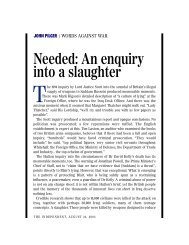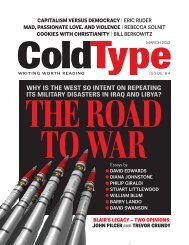UPDATED - ColdType
UPDATED - ColdType
UPDATED - ColdType
- TAGS
- updated
- coldtype
- coldtype.net
You also want an ePaper? Increase the reach of your titles
YUMPU automatically turns print PDFs into web optimized ePapers that Google loves.
A MILITARY VIEW<br />
EVEN experienced military people were turned<br />
off by all the media pandering. Writing in Army<br />
Times, Gulf War 1 veteran Ralf W. Zimmerman<br />
wrote:<br />
“Often contradictory news coverage of our war<br />
on terror has made me a bit suspicious of the<br />
control the Pentagon and other government<br />
agencies are exercising over what can and can’t<br />
be reported. Without access to the Internet<br />
(despite all its flaws) and other reliable western<br />
media sources, I’m afraid I’d have a rather<br />
incomplete picture of what is really shaping up<br />
in the world around us.<br />
“American war reporting seems to be governed<br />
by extremes, especially on television. We<br />
get either a sketchy tabloid report or the Pentagon’s<br />
edited party line. Both are readily available<br />
and mainly strive to entertain the public or to<br />
whip up superficial patriotism.”<br />
Many media organizations became an adjunct,<br />
to the selling of the war for political and economic<br />
reasons as well.<br />
Why?<br />
There were three principal reasons:<br />
1. Institutional changes in our media system.<br />
2. A shift in our media culture.<br />
3. A new sophistication by the military and<br />
government in the art of news management.<br />
MEDIA SYSTEM CHANGE<br />
THE American media system today is totally corporate<br />
dominated, market driven and hence, at<br />
its core, conservative in the sense that it rarely<br />
rocks the boat or challenges the status quo. It is<br />
more consolidated and, more paradoxically, frag-<br />
WHAT CAN WE DO ABOUT IT?<br />
245<br />
mented than ever. Diverse in appearance, it<br />
tends towards uniformity in content and conformity<br />
in method. Most news outlets act more<br />
alike even as they seem more different through<br />
positioning and “branding.”<br />
All fight for market share and “mind share.”<br />
All target the same demographics, covet the<br />
same advertisers, and offer similarly formatted<br />
and formularized programming. Infotainment<br />
has been dominant for 20 years on television. As<br />
entertainment companies took over news organizations,<br />
showbiz techniques were fused into<br />
newsbiz presentation style.<br />
This institutional dimension to the problem<br />
has been overlooked by most critics.<br />
The rise of Fox News has not changed this<br />
dynamic, even if it has added more polarization<br />
and patriotic correctness to the television spectrum.<br />
Studies have shown that whenever a broadcaster<br />
seems to be winning the constant race for<br />
ratings and revenues, others clone their look and<br />
adapt their attitude. Fox built its format on the<br />
experience of right-wing talk radio, adding personality,<br />
harder edge politics, and aggressive posturing<br />
to a news business known for centrism and<br />
blandness. As the new kid on the block, it played<br />
the patriotic card by hitching its wagon to a popular<br />
president who understood how to play to fear<br />
and insecurity while wrapping himself in the red,<br />
white and blue to boost approval ratings.<br />
By positioning itself as an alternative and antidote<br />
to a non-existent liberal media, it appealed<br />
to a hard core audience and those estranged by<br />
mainstream middle-of-the-road news. It served<br />
as the media shock troops for the Bush war<br />
offensive often framing news in a pro-administration<br />
direction while insisting on its fairness<br />
and balance.

















